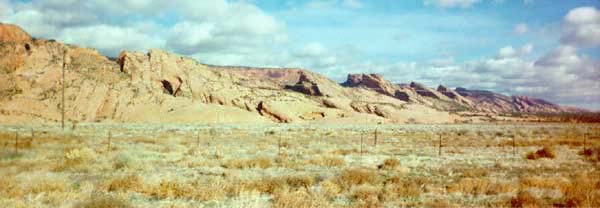

The Comb Ridge is a large structure of Navajo Sandstone that is first seen north of
Kayenta [Tódínéeshzhee']
and approximately parallels the highway for many miles until it turns north into Utah
[Gáamalii bikeyah Hahoodzo (Mormen country State)].
The ridge is the exposed end of the rock layers that have been bent at the Comb Monocline.
The layers of these rocks appear angled sharply upward relative to the horizontal, while
only a short distance away, rocks of the same formation appear level. The ridge is the
protruding edge of a layer which continues beneath the surface, again leveling in a
very short distance.
These rocks evidence steep, large scale cross bedding and have a tendency to weather into bare rounded surfaces. The "teeth" seen in the ridge in the photograph above are fairly evenly spaced and rounded, not sharp. Many erosion "holes" are also seen in the exposed surface of the rock. The cross bedding in the sandstone is due to the wind sorting of the original sands into dunes, such as those found in this area today, reformed from the same sands. Ripples from the original dunes are preserved in the stone.

References
© 1994 Karen M. Strom
Back to Day 2
